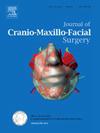虚拟手术计划骨膜下植入物。3年随访。适当管理的技巧和窍门。
IF 2.1
2区 医学
Q2 DENTISTRY, ORAL SURGERY & MEDICINE
引用次数: 0
摘要
严重的上颌萎缩是口腔康复面临的重大挑战,特别是对于拒绝常规骨增强手术的患者。本研究评估了12例极度萎缩患者(Cawood和Howell分类V类和VI类)数字计划骨膜下植入物3年的临床结果,分析了生存率、并发症模式,并提供了基于证据的技术建议。材料和方法:回顾性病例系列包括上颌萎缩患者,他们拒绝传统的种植体或植骨,而是选择在局部麻醉下立即加载。虚拟规划(面部CT/口内扫描)指导定制框架的制作,在截骨后通过自攻螺钉固定。采用基于频率的方法分析并发症。结果:12例患者均在术后24 h立即完成假体装填。4/12的病例出现并发症,包括框架暴露(2例,保守处理),术后出血(1例抗凝患者),1例因骨重塑不充分导致种植体失败(成功修复)。3年生存率为91.7%。结论:当患者拒绝全身麻醉或延长愈合时间时,虚拟计划的骨膜下植入物为严重萎缩提供了可靠的选择。主要建议包括避免外侧切口,使用双手术导尿管和预钻导孔。虽然在三分之一的病例中观察到并发症,但它们通常是可控的,不会损害长期功能。在精心挑选的患者中,骨膜下种植体是一种可行的立即康复选择,如果结合精心的计划和执行。本文章由计算机程序翻译,如有差异,请以英文原文为准。
Virtual surgical planned subperiosteal implants. 3 years of follow up. Tips and tricks for a proper management
Introduction
Severe maxillary atrophy presents significant challenges in oral rehabilitation, particularly for patients refusing conventional bone augmentation procedures. This study evaluates the 3-year clinical outcomes of digitally planned subperiosteal implants in 12 cases of extreme atrophy (Class V and VI of the Cawood and Howell Classification), analyzing survival rates, complication patterns, and providing evidence-based technical recommendations.
Materials and methods
A retrospective case series included patients with maxillary atrophy who declined conventional implants or bone grafting, opting instead for immediate loading under local anesthesia. Virtual planning (facial CT/intraoral scans) guided the fabrication of custom frameworks, fixed via self-tapping screws after osteotomy. Complications were analyzed using frequency-based methods.
Results
All 12 cases achieved immediate prosthetic loading (24 h post-surgery). Complications occurred in 4/12 of cases, including framework exposure (2 cases, managed conservatively), postoperative bleeding (1 anticoagulated patient), and one implant failure due to inadequate bone reshaping (successfully revised). The 3-year survival rate was 91.7 %.
Conclusions
Virtually planned subperiosteal implants offer a reliable alternative for severe atrophy when patients refuse general anesthesia or extended healing periods. Key recommendations include avoiding lateral incisions, using dual surgical guides, and pre-drilling pilot holes. While complications were observed in one-third of cases, they were typically manageable and did not compromise long-term function. Subperiosteal implants represent a viable option for immediate rehabilitation in carefully selected patients when combined with meticulous planning and execution.
求助全文
通过发布文献求助,成功后即可免费获取论文全文。
去求助
来源期刊
CiteScore
5.20
自引率
22.60%
发文量
117
审稿时长
70 days
期刊介绍:
The Journal of Cranio-Maxillofacial Surgery publishes articles covering all aspects of surgery of the head, face and jaw. Specific topics covered recently have included:
• Distraction osteogenesis
• Synthetic bone substitutes
• Fibroblast growth factors
• Fetal wound healing
• Skull base surgery
• Computer-assisted surgery
• Vascularized bone grafts

 求助内容:
求助内容: 应助结果提醒方式:
应助结果提醒方式:


